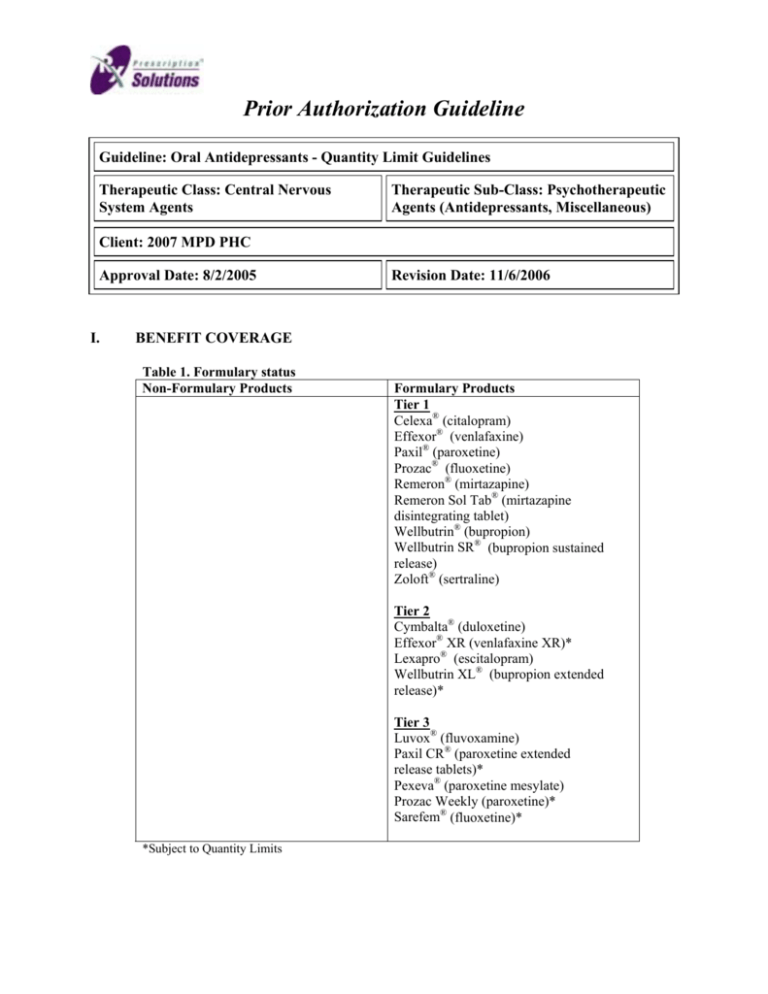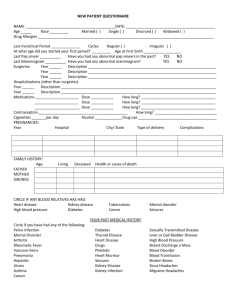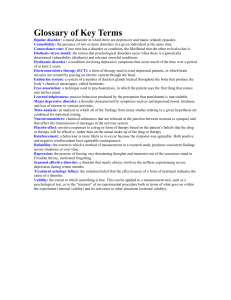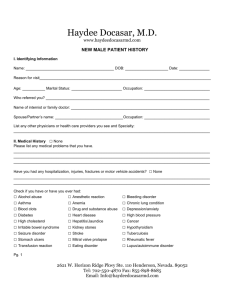
Prior Authorization Guideline
Guideline: Oral Antidepressants - Quantity Limit Guidelines
Therapeutic Class: Central Nervous
System Agents
Therapeutic Sub-Class: Psychotherapeutic
Agents (Antidepressants, Miscellaneous)
Client: 2007 MPD PHC
Approval Date: 8/2/2005
I.
Revision Date: 11/6/2006
BENEFIT COVERAGE
Table 1. Formulary status
Non-Formulary Products
Formulary Products
Tier 1
Celexa® (citalopram)
Effexor® (venlafaxine)
Paxil® (paroxetine)
Prozac® (fluoxetine)
Remeron® (mirtazapine)
Remeron Sol Tab® (mirtazapine
disintegrating tablet)
Wellbutrin® (bupropion)
Wellbutrin SR® (bupropion sustained
release)
Zoloft® (sertraline)
Tier 2
Cymbalta® (duloxetine)
Effexor® XR (venlafaxine XR)*
Lexapro® (escitalopram)
Wellbutrin XL® (bupropion extended
release)*
Tier 3
Luvox® (fluvoxamine)
Paxil CR® (paroxetine extended
release tablets)*
Pexeva® (paroxetine mesylate)
Prozac Weekly (paroxetine)*
Sarefem® (fluoxetine)*
*Subject to Quantity Limits
II.
INDICATIONS
A. FDA Approved Indications
1. Effexor XR
Major Depressive Disorder
Effexor XR extended-release capsules are indicated for the treatment of major depressive
disorder.
The efficacy of Effexor XR in the treatment of major depressive disorder was established
in 8- and 12-week controlled trials of adult outpatients whose diagnoses corresponded
most closely to the DSM-III-R or DSM-IV category of major depressive disorder.
Generalized Anxiety Disorder
Effexor XR is indicated for the treatment of Generalized Anxiety Disorder (GAD) as
defined in DSM-IV. Anxiety or tension associated with the stress of everyday life usually
does not require treatment with an anxiolytic.
Social Anxiety Disorder
Effexor XR is indicated for the treatment of Social Anxiety Disorder, also known as
Social Phobia, as defined in DSM-IV (300.23).
Panic Disorder
Effexor XR is indicated for the treatment of panic disorder, with or without agoraphobia,
as defined in DSM-IV. Panic disorder is characterized by the occurrence of unexpected
panic attacks and associated concern about having additional attacks, worry about the
implications or consequences of the attacks, and/or a significant change in behavior
related to the attacks.
2. Paxil CR
Major Depressive Disorder
Paxil CR is indicated for the treatment of major depressive disorder. The efficacy of
Paxil CR in the treatment of a major depressive episode was established in two 12-week
controlled trials of outpatients whose diagnoses corresponded to the DSM-IV category of
major depressive disorder.
Panic Disorder
Paxil CR is indicated for the treatment of panic disorder, with or without agoraphobia, as
defined in DSM-IV. Panic disorder is characterized by the occurrence of unexpected
panic attacks and associated concern about having additional attacks, worry about the
implications or consequences of the attacks, and/or a significant change in behavior
related to the attacks.
Social Anxiety Disorder
Paxil CR is indicated for the treatment of social anxiety disorder, also known as social
phobia, as defined in DSM-IV (300.23). Social anxiety disorder is characterized by a
marked and persistent fear of 1 or more social or performance situations in which the
person is exposed to unfamiliar people or to possible scrutiny by others. Exposure to the
feared situation almost invariably provokes anxiety, which may approach the intensity of
a panic attack. The feared situations are avoided or endured with intense anxiety or
distress. The avoidance, anxious anticipation, or distress in the feared situation(s)
interferes significantly with the person's normal routine, occupational or academic
functioning, or social activities or relationships, or there is marked distress about having
the phobias. Lesser degrees of performance anxiety or shyness generally do not require
psychopharmacological treatment.
Premenstrual Dysphoric Disorder
Paxil CR is indicated for the treatment of PMDD. The efficacy of Paxil CR in the
treatment of PMDD has been established in 3 placebo-controlled trials.
3. Prozac Weekly
Prozac is indicated for the treatment of major depressive disorder. The efficacy of Prozac
was established in 5- and 6-week trials with depressed adult and geriatric outpatients
(≥18 years of age) whose diagnoses corresponded most closely to the DSM-III (currently
DSM-IV) category of major depressive disorder.
The efficacy of Prozac Weekly once weekly in maintaining a response in major
depressive disorder has been demonstrated in a placebo-controlled trial for up to 25
weeks following open-label acute treatment of 13 weeks with Prozac 20 mg daily for a
total treatment of 38 weeks. However, it is unknown whether or not Prozac Weekly given
on a once-weekly basis provides the same level of protection from relapse as that
provided by Prozac 20 mg daily.
4. Sarafem
Premenstrual Dysphoric Disorder
Sarafem is indicated for the treatment of premenstrual dysphoric disorder (PMDD). The
efficacy of fluoxetine in the treatment of PMDD was established in 3 placebo-controlled
trials.
5. Wellbutrin XL
Major Depressive Disorder
Wellbutrin XL is indicated for the treatment of major depressive disorder.
The efficacy of bupropion in the treatment of a major depressive episode was established
in two 4-week controlled trials of inpatients and in one 6-week controlled trial of
outpatients whose diagnoses corresponded most closely to the Major Depression category
of the APA Diagnostic and Statistical Manual (DSM).
Seasonal Affective Disorder
Wellbutrin XL is indicated for the prevention of seasonal major depressive episodes in
patients with a diagnosis of seasonal affective disorder.
The efficacy of Wellbutrin XL for the prevention of seasonal major depressive episodes
was established in 3 controlled trials of adult outpatients with a history of major
depressive disorder with an autumn-winter seasonal pattern as defined by Diagnostic and
Statistical Manual of Mental Disorders, 4th edition (DSM-IV) criteria.
III.
GUIDELINE
A. Quantity Limits
1. The following quantities will process as formulary at the respective tiers:
Table 2: Quantity Limits
Drug Name and Strength
Effexor XR (37.5 mg, 75 mg)
Effexor XR (150 mg)
Paxil CR (12.5, 25, 37.5 mg)
Prozac Weekly (90 mg)
Sarafem (10, 20 mg)
Wellbutrin XL (150 mg)
Wellbutrin XL (300 mg)
Quantity Limit
93 capsules per 31 days
31 capsules per 31 days
62 tablets per 31 days
5 capsules per 31 days
62 capsules per 31 days
93 tablets per 31 days
31 tablets per 31 days
B. Quantity Limit Overrides
1. Quantity requests exceeding the limited amount per month for Paxil CR 12.5 mg, Paxil
CR 25 mg, Effexor XR 37.5 mg will be approved based on one of the following criteria:
a. For titration purposes (one time authorization)
-ORb. Requested strength/dose is commercially unavailable
-ORc. Patient is on a dose alternating schedule
2. Quantity requests exceeding the limited amount per month for Effexor XR 75 mg,
Effexor XR 150 mg, Paxil CR 37.5 mg, Prozac Weekly 90 mg, Wellbutrin XL 150
mg, Wellbutrin XL 300 mg will be approved based on the following criteria:
a. Failure or intolerance to all other formulary alternatives
-ANDb. One of the following:
(1) Higher dose or quantity is supported by the manufacturer's prescribing
information
-OR(2) Higher dose or quantity is supported by one of the three Medicare approved
compendia: American Hospital Formulary Service Drug Information, United
States Pharmacopeia - Drug Information, DRUGDEX Information System
-OR(3) Physician provides evidence to support safety and additional efficacy at higher
than maximum doses as documented in published biomedical literature
demonstrating safety and efficacy of doses/quantities greater than those approved
by the FDA for the diagnosis indicated
-ANDc. Physician acknowledgement that benefit attained outweigh the risk associated with
the higher dose or quantity
2. Quantity requests exceeding the limited amount per month for Sarafem 10 mg, or
Sarfem 20 mg will be approved based on the following criteria:
a. Diagnosis of premenstrual dysphoric disorder (PMDD)
Sarafem can be authorized to provide up to a maximum of 240 capsules (80mg/day)
IV.
CONTRAINDICATIONS AND WARNINGS
A. Contraindications
1. Hypersensitivity
Effexor XR, Paxil CR, Prozac, Sarafem, and Wellbutrin XL are contraindicated in
patients with hypersensitivity to any active ingredient or to any excipients in the
formulation.
2. Monoamine Oxidase Inhibitors
Effexor XR, Paxil CR, Prozac, Sarafem, and Wellbutrin XL are contraindicated in
patients taking monoamine oxidase inhibitors (MAOIs).
Effexor XR, Paxil CR, Prozac, Sarafem, and Wellbutrin XL should not be used in
combination with an MAOI, or within a minimum of 14 days of discontinuing therapy
with an MAOI. Since fluoxetine and its major metabolite have very long elimination halflives, at least 5 weeks [perhaps longer, especially if fluoxetine has been prescribed
chronically and/or at higher doses should be allowed after stopping Prozac or Sarafem
before starting an MAOI.
3. Concomitant use with pimozide
Paxil CR and Prozac Weekly are contraindicated in patients concomitantly taking
pimozide.
4. Concomitant use with thioridazine
Thioridazine should not be administered with Prozac or Sarafem within a minimum of 5
weeks after Prozac has been discontinued
5. Seizure disorder
Wellbutrin XL is contraindicated in patients with a seizure disorder.
6. Concomitant use with other bupropion products
Wellbutrin XL is contraindicated in patients treated with Zyban (bupropion
hydrochloride) Sustained-Release Tablets; Wellbutrin (bupropion hydrochloride), the
immediate-release formulation; Wellbutrin SR (bupropion hydrochloride), the sustainedrelease formulation; or any other medications that contain bupropion because the
incidence of seizure is dose dependent.
7. Patients with bulimia or anorexia nervosa
Wellbutrin XL is contraindicated in patients with a current or prior diagnosis of bulimia
or anorexia nervosa because of a higher incidence of seizures noted in patients treated for
bulimia with the immediate-release formulation of bupropion.
8. Discontinuation of alcohol or sedatives
Wellbutrin XL is contraindicated in patients undergoing abrupt discontinuation of alcohol
or sedatives (including benzodiazepines).
B. Warnings
1. Black Box Warning
Suicidality in Children and Adolescents
Antidepressants increased the risk of suicidal thinking and behavior (suicidality) in short
term studies in children and adolescents with Major Depressive Disorder (MDD) and
other psychiatric disorders. Anyone considering the use of any other antidepressant in a
child or adolescent must balance this risk with the clinical need. Patients who are started
on therapy should be observed closely for clinical worsening, suicidality, or unusual
changes in behavior. Families and caregivers should be advised of the need for close
observation and communication with the prescriber.
Pooled analyses of short-term (4 to 16 weeks) placebo-controlled trials of 9
antidepressant drugs (SSRIs and others) in children and adolescents with major
depressive disorder (MDD), obsessive compulsive disorder (OCD), or other psychiatric
disorders (a total of 24 trials involving over 4400 patients) have revealed a greater risk of
adverse events representing suicidal thinking or behavior (suicidality) during the first few
months of treatment in those receiving antidepressants. The average risk of such events in
patients receiving antidepressants was 4%, twice the placebo risk of 2%. No suicides
occurred in these trials.
2. Screening Patients for Bipolar Disorder
A major depressive episode may be the initial presentation of bipolar disorder. It is
generally believed (though not established in controlled trials) that treating such an
episode with an antidepressant alone may increase the likelihood of precipitation of a
mixed/manic episode in patients at risk for bipolar disorder.
Prior to initiating treatment with an antidepressant, patients with depressive
symptoms should be adequately screened to determine if they are at risk for bipolar
disorder; such screening should include a detailed psychiatric history, including a
family history of suicide, bipolar disorder, and depression.
3. Potential for Interaction with Monoamine Oxidase Inhibitors
In patients receiving a serotonin reuptake inhibitor in combination with a monoamine
oxidase inhibitor, there have been reports of serious, sometimes fatal, reactions
including hyperthermia, rigidity, myoclonus, autonomic instability with possible
rapid fluctuations of vital signs, and mental status changes that include extreme
agitation progressing to delirium and coma. These reactions have also been reported
in patients who have recently discontinued serotonin reuptake inhibitors and are then
started on an MAOI. Some cases presented with features resembling neuroleptic
malignant syndrome.
4.
Serotonin Syndrome
The development of a potentially life-threatening serotonin syndrome may occur with
antidepressant treatment, particularly with concomitant use of serotonergic drugs
(including SSRIs, SNRIs and triptans) and with drugs that impair metabolism of
serotonin (including MAOIs). Serotonin syndrome symptoms may include mental status
changes (e.g., agitation, hallucinations, coma), autonomic instability (e.g., tachycardia,
labile blood pressure, hyperthermia), neuromuscular aberrations (e.g., hyperreflexia,
incoordination) and/or gastrointestinal symptoms (e.g., nausea, vomiting, diarrhea).
5. Sustained Hypertension
Effexor XR: Venlafaxine treatment is associated with sustained increases in blood
pressure in some patients.
6. Mydriasis
Effexor XR: Mydriasis has been reported in association with venlafaxine; therefore
patients with raised intraocular pressure or those at risk of acute narrow-angle glaucoma
(angle-closure glaucoma) should be monitored.
7. Teratogenic Effects
Paxil CR: Epidemiological studies have shown that infants born to women who had first
trimester paroxetine exposure had an increased risk of cardiovascular malformations,
primarily ventricular and atrial septal defects (VSDs and ASDs). In general, septal
defects range from those that are symptomatic and may require surgery to those that are
asymptomatic and may resolve spontaneously. If a patient becomes pregnant while taking
paroxetine, she should be advised of the potential harm to the fetus. Unless the benefits of
paroxetine to the mother justify continuing treatment, consideration should be given to
either discontinuing paroxetine therapy or switching to another antidepressant. For
women who intend to become pregnant or are in their first trimester of pregnancy,
paroxetine should only be initiated after consideration of the other available treatment
options.
V.
DOSING
Effexor XR
Major Depressive Disorder
Starting dose: 75 mg/day, administered in a single dose.
Patients not responding may benefit from dose
increases to a maximum of approximately 225 mg/day.
Dose increases should be in increments of up to 75
mg/day, as needed, and should be made at intervals of
not less than 4 days.
In one study, more severely depressed inpatients
responded to a mean dose of 350 mg/day (range of 150
to 375 mg/day). Whether or not higher doses of Effexor
XR are needed for more severely depressed patients is
unknown; however, the experience with Effexor XR
doses higher than 225 mg/day is very limited.
Generalized Anxiety Disorder
Starting dose: 75 mg/day, administered in a single dose.
Certain patients not responding to the initial 75 mg/day
dose may benefit from dose increases to a maximum of
approximately 225 mg/day.
Social Anxiety Disorder
Starting dose: 75 mg/day, administered in a single dose.
Certain patients not responding to the initial 75 mg/day
dose may benefit from dose increases to a maximum of
approximately 225 mg/day.
Panic Disorder
Paxil CR
Major Depressive Disorder
Starting dose: 37.5 mg/day, administered in a single
dose for 7 days, then 75 mg/day and subsequent weekly
dose increases up to 225 mg.day
Starting Dose: 25 mg/day administered as a single daily
dose.
Some patients not responding to a 25-mg dose may
benefit from dose increases, in 12.5-mg/day increments,
up to a maximum of 62.5 mg/day. Dose changes should
occur at intervals of at least 1 week.
Premenstrual Dysphoric Disorder
12.5 mg/day.
In clinical trials, both 12.5 mg/day and 25 mg/day were
shown to be effective.
Social Anxiety Disorder
Starting Dose: 12.5 mg/day administered as a single
daily dose.
Patients were dosed in a range of 12.5 mg to 37.5
mg/day in clinical trials.
Panic Disorder
Starting Dose: 12.5 mg/day administered as a single
daily dose.
Patients were dosed in a range of 12.5 to 75 mg/day in
clinical trials.
Prozac Weekly
Major Depressive Disorder
90 mg once weekly.
Weekly dosing with Prozac Weekly capsules is
recommended to be initiated 7 days after thelast daily
dose of Prozac 20 mg.
Sarafem
Premenstrual Dysphoric Disorder
20 mg/day given continuously (every day of the
menstrual cycle) or intermittently (defined as starting
daily dose 14 days prior to the anticipated onset of
menstruation through the first full day of menses and
repeating with each cycle.
In a study comparing continuous dosing of fluoxetine
20 and 60 mg/day to placebo, both doses were proven
to be effective, but there was no statistically significant
added benefit for the 60-mg/day compared with the 20mg/day dose. Fluoxetine doses above 60 mg/day have
not been systematically studied in patients with PMDD.
The maximum fluoxetine dose should not exceed 80
mg/day.
Wellbutrin XL
Major Depressive Disorder
The usual adult target dose is 300 mg/day, given once
daily in the morning. Dosing should begin at 150 mg
given as a single dose. If the 150 mg dose is adequately
tolerated, an increase to 300 mg/day may be made.
Doses above 300 mg/day have not been studied for the
prevention of seasonal major depressive episodes.
Seasonal Affective Disorder
The usual adult target dose is 300 mg/day, given once
daily in the morning. Dosing should begin at 150 mg
given as a single dose. If the 150 mg dose is
adequately tolerated, an increase to 300 mg/day may be
made as early as day 4 of dosing.
An increase in dosage to the maximum of 450 mg/day
may be considered for patients in whom no clinical
improvement is noted after several weeks of treatment.
VI.
AVAILABILITY1,2
Effexor XR extended-release capsules: 37.5 mg, 75 mg, 150 mg.
Paxil CR controlled-release tablets: 12.5 mg, 25 mg, 37.5 mg
Prozac Weekly capsules: 90 mg
Sarafem capsules: 10 mg, 20 mg
Wellbutrin XL tablets: 150 mg, 300 mg
VII.
REFERENCES
1.
2.
3.
4.
5.
Effexor XR Prescribing Information. Wyeth Pharmaceuticals Inc. August 2006.
Wellbutrin XL Prescribing Information. GlaxoSmithKline. June 2006.
Sarafem Prescribing Information. Eli Lilly and Company. August 2006.
Prozac Prescribing Information. Eli Lilly and Company. August 2006.
Paxil CR Prescribing Information. GlaxoSmithKline. July 2006.
This Prior Authorization Guideline represents the recommendation of Prescription Solutions’ Pharmacy and Therapeutics (P&T) Committee.
It is based upon the P&T Committee’s review of the available evidence as of the date of drafting or revision of this Prior Authorization
Guideline. It is subject to updating from time to time, based upon changes in scientific knowledge and information.
This Prior Authorization Guideline is intended as a resource for making coverage decisions for Health Plan members, but it does not replace
an individualized case-by-case review and medical necessity determination for each Health Plan member.
Copyright © 2006 by Prescription Solutions. All rights reserved. This Prior Authorization Guideline is intended for use by Prescription
Solutions and Health Plan employees and applicable contracted providers and practitioners only. The information contained in this Prior
Authorization Guideline is confidential and proprietary to Prescription Solutions and shall not be used, reproduced, or transferred in whole or
in part without Prescription Solutions’ prior written consent.





